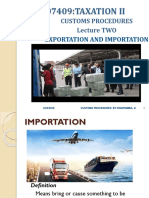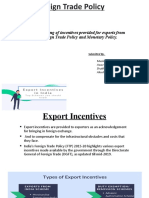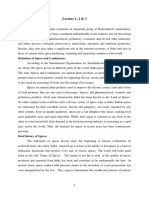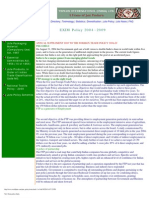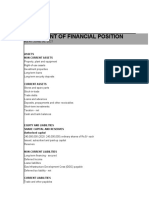India Foreign Trade Policy
India Foreign Trade Policy
Uploaded by
abhilash k.bCopyright:
Available Formats
India Foreign Trade Policy
India Foreign Trade Policy
Uploaded by
abhilash k.bCopyright
Available Formats
Share this document
Did you find this document useful?
Is this content inappropriate?
Copyright:
Available Formats
India Foreign Trade Policy
India Foreign Trade Policy
Uploaded by
abhilash k.bCopyright:
Available Formats
Indias new foreign trade policy: Old wine in new bottles
The recently released new five-year national Foreign Trade Policy (FTP) of India has set a few objectives. Given the current financial crisis, it is also intended to provide a confidence boost for the export market. Its objectives are ambitious. Fiscal incentives, institutional changes, procedural rationalisation, and enhanced market access across the world, as well as the diversification of export markets are the trust areas mentioned in the document. However, the document doesnt provide any new thoughts and lacks any bold initiative in terms of longer term objectives. It is the same old type of bureaucratic exercise that the Commerce Ministry has been carrying out for decades. The continuation of the same old policies, such as targeting a set of trade or export goals, mentioning a few sectors of importance and reshaping fiscal packages is as flawed as past approaches. It lacks proper mechanisms for future planning, and will be unable to examine past failures which have limited the Indian share to a mere 1 per cent of global trade for decades. The FTP sets a policy objective of achieving an annual export growth rate of 15 per cent, and an annual export target of US$200 billion by March 2011. In the remaining three years, the FTP proposes a high export growth path of around 25 per cent per annum, and expects to double Indias exports of goods and services. The long term policy objective is to double Indias share in global trade by 2020. This may not be achievable if the Commerce Ministry doesnt go beyond its traditional way of thinking. The FTP alludes to the success of Chinese efforts to increase their trade, and recommends adopting a similar strategy to increase exports in the Indian manufacturing sector. This is a positive step, but a lot of ground work will be required to implement this. Change has to come from the bureaucracy first. The productivity of Indian bureaucrats must be increased, corruption must be reduced, and FDI policies must be liberalized to attract greater investment. As for means, the new FTP appears to be based on three main pillars. Firstly, the short-term objective is to arrest and reverse the declining trend of exports and to provide additional support to sectors hit badly by recession in the developed world. Secondly, support for market and product diversification is targeted. 26 new markets have been added under the Focus Market Scheme. These include 16 new markets in Latin America and 10 in Asia-Oceania. The incentive available under the Focus Market Scheme (FMS) has been raised from 2.5 per cent to 3 per cent. The incentive available under Focus Product Scheme (FPS) has been raised from 1.25 per cent to 2 per cent. Thirdly, objectives and commitments to ensure increased employment opportunities, addressing the issues of labour-intensive exports and making the export business more convenient and trouble free are targeted by bringing down transaction costs, and improving infrastructure related to exports . Gems and jewellery, textiles, leather, auto components and pharmaceuticals are declared labour-intensive sectors getting special dole and attention in the policy. Repositioning income tax in the IT sector, and altering the duty on engineering and electronic products, as well as others, are part of a raft of policy measures. Most of the schemes, however, are geared towards the short term objective of preventing exports further declining, and fiscal incentives do not go beyond the period of 2011. What difference does it make to raise the FMS from 2.5 per cent to 3 per cent and the FPS from 1.25 per cent to 2 per cent?. Just changing these nominal figures will not have any real impact. Moreover, these are the acronyms that we have been polishing, renaming and reintroducing with a view to changing the nominal figures in every FTP that the Ministry has released in the past. How many in the export market really bother about these figures mentioned in these policy documents? A previous post on this same topic by Rajiv Kumar of ICRIER reveals that a recent survey of 400 exporting firms as a part of a study showed that up to 20 per cent of exporters do not avail
themselves of export incentives due to the hassles involved and more than 50 per cent admitted to having had to incur some expenditure to avail the benefits under various schemes. So the problems lie else where, not in the tips the government provides every five years. The new FTP proposes the promotion of Brand India through six or more Made in India shows to be organized across the world every year. This is a supplementary step, and it should not be a wholly government funded program. Indian multinationals and Small and Medium Enterprises (SMEs) should be brought in as main sponsors and be encouraged to carry it in the future with the help of industrial organisations abroad. Moreover, it is not only the brand that matters but the quality, competiveness and availability of Indian products in foreign markets. People see the price and quality first before looking at what country has produced it. Have the FTPs ever looked to increase quantity in an existing market? For example, the availability of Indian manufactured goods in Japan and Australia is minimumal, where the people are aware of the quality of Indian manufactured items such as textile and leather products, and it will be true in other markets too around the world. Take any department storeroom in Japan or Australia. For every 30 or 40 Chinese commodities on display, there will be perhaps one from India. It is not a problem of concessions or incentives. Here, trade agreements play an important role in increasing the trade and investment between countries. So along the measures mentioned in the FTP, India has to push forward its FTA policies, encourage the private sector to open up and let them provide the incentives for more interaction between Indian and foreign companies. In this era of global competitiveness, there is a desperate need for Indian exporters to upgrade their technology and reduce their costs. Accordingly, an important element of the FTP is to help exporters upgrade technologically. It is hard to believe that we only realised very recently the importance of technology and importing needed capital to increase the quality and productivity of our manufacturing sector, as the new FTP proposes to promote the imports of capital goods for certain sectors. Whether the initiatives proposed in the new FTP, by which the government envisages to achieve such an ambitious outcome, will be sufficient is unclear. In particular, it is doubtful whether export-related duty exemptions and preferential treatment of economic agents are the best way to promote economic efficiency and growth. So there are many structural impediments to overcome before we redraft these occasional exercises of fiscal sops. On the one hand, across-the-board liberalisation efforts should be continued. On the other hand, duty exemptions and other privileges geared mainly towards export promotion are to be enhanced. In fact, if the first objective is realised, the second, at least when it comes to import duty exemptions, becomes redundant. It seems that across-the-board import duty reduction can be of more benefit economywide than selective duty exemptions in export sectors. Moreover, the larger question of making Indian exports more competitive needs a much more comprehensive set of policy responses. Such a policy response is not limited to one Ministry and therefore, the government as a whole needs to act in unison if these basic problems are to be addressed.
You might also like
- New Balance $31,734.27 Minimum Payment Due $587.00 Payment Due Date 09/23/22Document14 pagesNew Balance $31,734.27 Minimum Payment Due $587.00 Payment Due Date 09/23/22Rahul SharmaNo ratings yet
- 10JUNE23 Quiz Question FinanceDocument2 pages10JUNE23 Quiz Question FinanceShaleeena Aihara0% (1)
- Slides MottaDocument166 pagesSlides Mottaelrodrigazo100% (4)
- AB3601 Critical ThinkingDocument5 pagesAB3601 Critical ThinkingAriebima AbigaraNo ratings yet
- 300+ Top Sales Management Mcqs and Answers: Any Skill SearDocument14 pages300+ Top Sales Management Mcqs and Answers: Any Skill SearSurender ZimidarNo ratings yet
- FTP 2004-2009Document81 pagesFTP 2004-2009Mayank Jain100% (1)
- The Gap Model of A RestaurantDocument13 pagesThe Gap Model of A RestaurantPrateek ShettyNo ratings yet
- My Catfish Business PlanDocument13 pagesMy Catfish Business PlanYemi Ade100% (1)
- How Process Enterprises Really WorkDocument2 pagesHow Process Enterprises Really WorkchanduNo ratings yet
- India Export PromotionDocument8 pagesIndia Export PromotionUdit PradeepNo ratings yet
- Exportation and ImportationDocument31 pagesExportation and ImportationCristian RenatusNo ratings yet
- Export & ImportDocument12 pagesExport & ImportArijeet Aneja100% (1)
- Supply Chain Practices at Domino'SDocument16 pagesSupply Chain Practices at Domino'SAman Goyal (B19ME004)No ratings yet
- Foreign Trade Policy: - Listing and Describing of Incentives Provided For Exports FromDocument9 pagesForeign Trade Policy: - Listing and Describing of Incentives Provided For Exports FromShubham SinghNo ratings yet
- Front Office Accounting FormatsDocument10 pagesFront Office Accounting FormatsDebasish Singha100% (1)
- Business Plan (Mobile Van)Document26 pagesBusiness Plan (Mobile Van)Praveen PillaiNo ratings yet
- FSSAI SoPs For ImportsDocument15 pagesFSSAI SoPs For ImportsChiragVedNo ratings yet
- Biryani Center Final ReportDocument20 pagesBiryani Center Final ReportCozil AltafNo ratings yet
- Project Report Product & Pricing Strategy: Submission Date: June 2, 2012Document34 pagesProject Report Product & Pricing Strategy: Submission Date: June 2, 2012Qasim ZiaNo ratings yet
- SOP CF 014 Monthly Food Beverage Cost Report-1Document4 pagesSOP CF 014 Monthly Food Beverage Cost Report-1Abdul RezakNo ratings yet
- Job Description For Restaurant ManagerDocument2 pagesJob Description For Restaurant Managerobabaru gaddis ivanNo ratings yet
- IC Simple Business Plan 10785 - PDFDocument13 pagesIC Simple Business Plan 10785 - PDFNguyễn Minh HuyềnNo ratings yet
- OS Front Office Service Level I-IVDocument194 pagesOS Front Office Service Level I-IVkassahun argawNo ratings yet
- Job Desk of Chief StewardDocument3 pagesJob Desk of Chief StewarddenisNo ratings yet
- A Project Report On: Fruit Delight RestaurantDocument36 pagesA Project Report On: Fruit Delight RestaurantsalmanNo ratings yet
- Food Production-By Arup Dutta (Pursing PHD in Molecular Gastronomy, MBA (HR), BHMDocument70 pagesFood Production-By Arup Dutta (Pursing PHD in Molecular Gastronomy, MBA (HR), BHMARUP DUTTANo ratings yet
- QSRDocument41 pagesQSRVivek VkNo ratings yet
- Check List For Import Custom Clearance at IndiaDocument2 pagesCheck List For Import Custom Clearance at Indiaapi-127528443No ratings yet
- Progress ReportDocument4 pagesProgress ReportAbuzeid MaherNo ratings yet
- Import Export BusinessDocument14 pagesImport Export BusinessOmkar HindujaNo ratings yet
- Internship Report On Community Development Program at The Paraspara TrustDocument20 pagesInternship Report On Community Development Program at The Paraspara TrustLikhitha annapuraNo ratings yet
- Restaurant Project ReportDocument8 pagesRestaurant Project ReportGARGINo ratings yet
- SpicesDocument42 pagesSpicesDeepu LeelNo ratings yet
- Role of Export Promotion Councils in IndiaDocument17 pagesRole of Export Promotion Councils in IndiaSarbeshwar Sahoo100% (1)
- Research On Career Scope of Hotel ManagementDocument70 pagesResearch On Career Scope of Hotel ManagementSaransh SainiNo ratings yet
- TS-06 Solved Assignment 2023Document15 pagesTS-06 Solved Assignment 2023122 - M BhumishNo ratings yet
- Export of Chilli From IndiaDocument3 pagesExport of Chilli From IndiaSebin Sara SolomonNo ratings yet
- Groundnut OilDocument40 pagesGroundnut OilYem Ane0% (1)
- January/February Examination) : (Slide 6-6)Document4 pagesJanuary/February Examination) : (Slide 6-6)Henry tNo ratings yet
- Hospitality ServicesDocument15 pagesHospitality ServicesBrijeshNo ratings yet
- Cost Accounting Project - CSDDocument31 pagesCost Accounting Project - CSDMuhammad TalhaNo ratings yet
- Food & Beverage Information Project Markets Stream - SingaporeDocument25 pagesFood & Beverage Information Project Markets Stream - SingaporecoriolisresearchNo ratings yet
- PNL Template For Restaurant SuccessDocument4 pagesPNL Template For Restaurant Successnqobizitha giyaniNo ratings yet
- TOWS Analysis Is A Variant of The Classic Business ToolDocument6 pagesTOWS Analysis Is A Variant of The Classic Business Toolsyed_murshedNo ratings yet
- Comparitive Analysis of Shoppers Stop N WestsideDocument24 pagesComparitive Analysis of Shoppers Stop N WestsideSunita Chowdhury100% (11)
- Chapter 1 Introduction To Catering IndustryDocument26 pagesChapter 1 Introduction To Catering Industrymd saiful islam simulNo ratings yet
- Pearl Continental Hotels Code of ConductDocument9 pagesPearl Continental Hotels Code of ConductayeshajamilafridiNo ratings yet
- Import - Export Policy of IndiaDocument13 pagesImport - Export Policy of Indiaravi pratapNo ratings yet
- Opportunities of Cheese Market in INDIA PDFDocument44 pagesOpportunities of Cheese Market in INDIA PDFMegha ParanjpeNo ratings yet
- Cost and Sales ConceptsDocument49 pagesCost and Sales ConceptsGallenaNo ratings yet
- Notice of Material Breach - Nice Ride Minnesota PDFDocument2 pagesNotice of Material Breach - Nice Ride Minnesota PDFandyrigaNo ratings yet
- Ts-003: Management in Tourism Guess Paper-IDocument39 pagesTs-003: Management in Tourism Guess Paper-IArshdeep SinghNo ratings yet
- FTP Icai MaterialDocument61 pagesFTP Icai MaterialsubbuNo ratings yet
- Exim PolicyDocument22 pagesExim PolicyTarun Arora100% (1)
- Assignment On: Marketing Plan On ShampooDocument12 pagesAssignment On: Marketing Plan On ShampoobarshanNo ratings yet
- Indian Restaurant Congress 2018 BrochureDocument16 pagesIndian Restaurant Congress 2018 BrochureSakshiNo ratings yet
- HMT Watches Revival of A Failed BrandDocument22 pagesHMT Watches Revival of A Failed BrandDarsh JainNo ratings yet
- Research - EDB PPT 17 12Document67 pagesResearch - EDB PPT 17 12Vijayant Kumar PandeyNo ratings yet
- Production & Operations Management Final Report PDFDocument12 pagesProduction & Operations Management Final Report PDFVictoria KorytskaNo ratings yet
- Supply Chain Management Project On Adigas Catering ServicesDocument15 pagesSupply Chain Management Project On Adigas Catering ServicesPrashant VashishtNo ratings yet
- Banquets Definition of BanquetDocument17 pagesBanquets Definition of BanquetARUN JOSENo ratings yet
- Trade Policy ThesisDocument6 pagesTrade Policy Thesisleanneuhlsterlingheights100% (2)
- New Exim Policy IndiaDocument6 pagesNew Exim Policy IndiaNibha GoyalNo ratings yet
- New Foreign Trade Policy 2021-2026 - Latest UpdatesDocument4 pagesNew Foreign Trade Policy 2021-2026 - Latest UpdatesGhNo ratings yet
- The Impact of Foreign Trade Policy 2015-2020 On Inclusive Growth of IndiaDocument3 pagesThe Impact of Foreign Trade Policy 2015-2020 On Inclusive Growth of IndiaGarima ChandraNo ratings yet
- Achieving Export Competitiveness25102017Document3 pagesAchieving Export Competitiveness25102017ShujaatAhmedNo ratings yet
- Niti Aayog MCQDocument2 pagesNiti Aayog MCQabhilash k.b50% (4)
- MCQ Price TheoryDocument2 pagesMCQ Price Theoryabhilash k.bNo ratings yet
- Gce o Level Past Paper Qs and AnswersDocument4 pagesGce o Level Past Paper Qs and Answersabhilash k.bNo ratings yet
- MCQ On Central BankDocument2 pagesMCQ On Central Bankabhilash k.bNo ratings yet
- Question Bank On Central Banks MCQsDocument20 pagesQuestion Bank On Central Banks MCQsabhilash k.b78% (9)
- Simultaneous Elections: Will This Be Good For India?Document13 pagesSimultaneous Elections: Will This Be Good For India?abhilash k.bNo ratings yet
- Finance Commissions AppointedDocument3 pagesFinance Commissions Appointedabhilash k.bNo ratings yet
- Business and Economics Key Terms Business and Economics Key TermsDocument69 pagesBusiness and Economics Key Terms Business and Economics Key Termsabhilash k.bNo ratings yet
- Family Planning Fact Sheets MaldivesDocument6 pagesFamily Planning Fact Sheets Maldivesabhilash k.bNo ratings yet
- Swot AnalysisDocument5 pagesSwot AnalysisHariprasad KS100% (1)
- Sales Pitch AssignmentDocument2 pagesSales Pitch AssignmentRahmad NadzriNo ratings yet
- QCM Finance CompletDocument432 pagesQCM Finance CompletLinh PhamNo ratings yet
- Forward and Futures ContractsDocument29 pagesForward and Futures ContractsMaulik ShahNo ratings yet
- 13.1 The Importance of The Level of Product AvailabilityDocument3 pages13.1 The Importance of The Level of Product AvailabilityMeo OlaNo ratings yet
- Financial Markets and ServicesDocument18 pagesFinancial Markets and ServicesChand .TandonNo ratings yet
- Week 1 HW SolutionDocument2 pagesWeek 1 HW Solutiontucker jacobsNo ratings yet
- SNT01 Group4 PPTDocument21 pagesSNT01 Group4 PPTThea SalvadorNo ratings yet
- Strategic Marketing Lecture 3Document13 pagesStrategic Marketing Lecture 3KhanMuhammadNo ratings yet
- Critical Situational Analysis and Business JustificationDocument17 pagesCritical Situational Analysis and Business JustificationAmolo OukoNo ratings yet
- Achieving Agility Defining Agility in An IT ContextDocument8 pagesAchieving Agility Defining Agility in An IT ContextsarangtikusNo ratings yet
- 15 The Concept of Logistics and Logistics-EfficiencyDocument14 pages15 The Concept of Logistics and Logistics-EfficiencyMiloš RadičevićNo ratings yet
- Abdul Wasay Roll No 53. Sec ADocument51 pagesAbdul Wasay Roll No 53. Sec AMuhammad Hammad RajputNo ratings yet
- ECONOMICS Answer Key Kerala Plus Two Second Term Exam Dec 2018Document2 pagesECONOMICS Answer Key Kerala Plus Two Second Term Exam Dec 2018ananya anuNo ratings yet
- STP PPT (Anubhav Bansal)Document36 pagesSTP PPT (Anubhav Bansal)anubhav bansalNo ratings yet
- ScheduleofCost PractiseQuestionDocument3 pagesScheduleofCost PractiseQuestionbharteshdas100% (2)
- DRM-5 Options BasicsDocument22 pagesDRM-5 Options BasicsqazxswNo ratings yet
- Adam Khoo OTS2018 Presentation SlidesDocument38 pagesAdam Khoo OTS2018 Presentation Slidesshree bNo ratings yet
- Economics English Booklet 104 PagesDocument106 pagesEconomics English Booklet 104 PagesRaghu PrasadNo ratings yet
- What Is Raising CapitalDocument8 pagesWhat Is Raising CapitalAgung BudiNo ratings yet
- Sample Financial PlanDocument19 pagesSample Financial PlanAlexandria Gonzales100% (1)
- SillabusDocument10 pagesSillabusDhani RamadhanNo ratings yet
- Shahzeb FInalDocument72 pagesShahzeb FInalArpit TewariNo ratings yet
- IAS 33 Earnings Per Share: Basic EPS Is Calculated AsDocument16 pagesIAS 33 Earnings Per Share: Basic EPS Is Calculated Asismat jahanNo ratings yet










